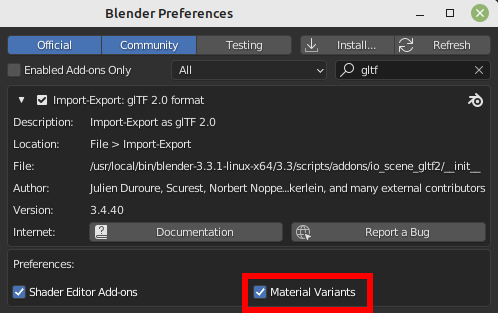glTF 2.0
Referencia
- Categoría:
Importar-Exportar
- Menú:
Uso
glTF™ (GL Transmission Format) es utilizado para la transmisión y la carga de modelos 3D en aplicaciones web y nativas. glTF reduce el tamaño de los modelos 3D y el procesamiento del runtime necesario para desempaquetar y representar aquellos modelos. Este formato es comúnmente usado en la web, y tiene soporte en varios motores 3D tales como Unity3D, Unreal Engine 4 y Godot.
Este importador/exportador soporta las siguientes características glTF 2.0:
Mallas
Materiales (Principled BSDF) and Shadeless (Unlit)
Texturas
Cámaras
Luces puntuales (punto, focal, y direccional)
Extensions (listed below)
Extras (propiedades personalizadas)
Animación (keyframe, clave de forma, and skinning)
Mallas
La estructura interna de glTF imita los buffers de memoria comúnmente utilizados por chips gráficos durante el procesamiento en tiempo real, de modo que los recursos puedan ser entregados a clientes de escritorio, web o móviles y ser mostrados rápidamente con un cálculo mínimo. Como resultado, los cuadriláteros y los enégonos serán convertidos automáticamente en triángulos, cuando sean exportados a glTF. Los UV discontinuos y los bordes con sombreado definido podrán dar como resultado una cantidad de vértices moderadamente más alta en glTF en comparación con Blender, ya que dichos vértices se separarán para la exportación. Del mismo modo, las curvas y otros datos que no sean mallas no serán conservados y deberán ser convertidos en mallas antes de la exportación.
GPU Instances
When the option is enable in Exporter, instances are exported using the EXT_mesh_gpu_instancing extension.
There are some limitations, at export:
Instances must be meshes, and don’t have any children themselves
Instances must all be children of the same object.
This extension doesn’t manage material variation. That means that the generated file may include all instances with same materials.
Instances detected are objects sharing the same mesh data.
At import, instances are created by creating objects sharing the same mesh data.
Materiales
El sistema central de materiales en glTF soporta un flujo de trabajo metal/rough PBR con los siguientes canales de información:
Color Base
Metálico
Rugosidad
Baked Ambient Occlusion
Normal Map (tangent space, +Y up)
Emisivo
Some additional material properties or types of materials can be expressed using glTF extensions. The complete list can be found in Extensions part of this documentation.
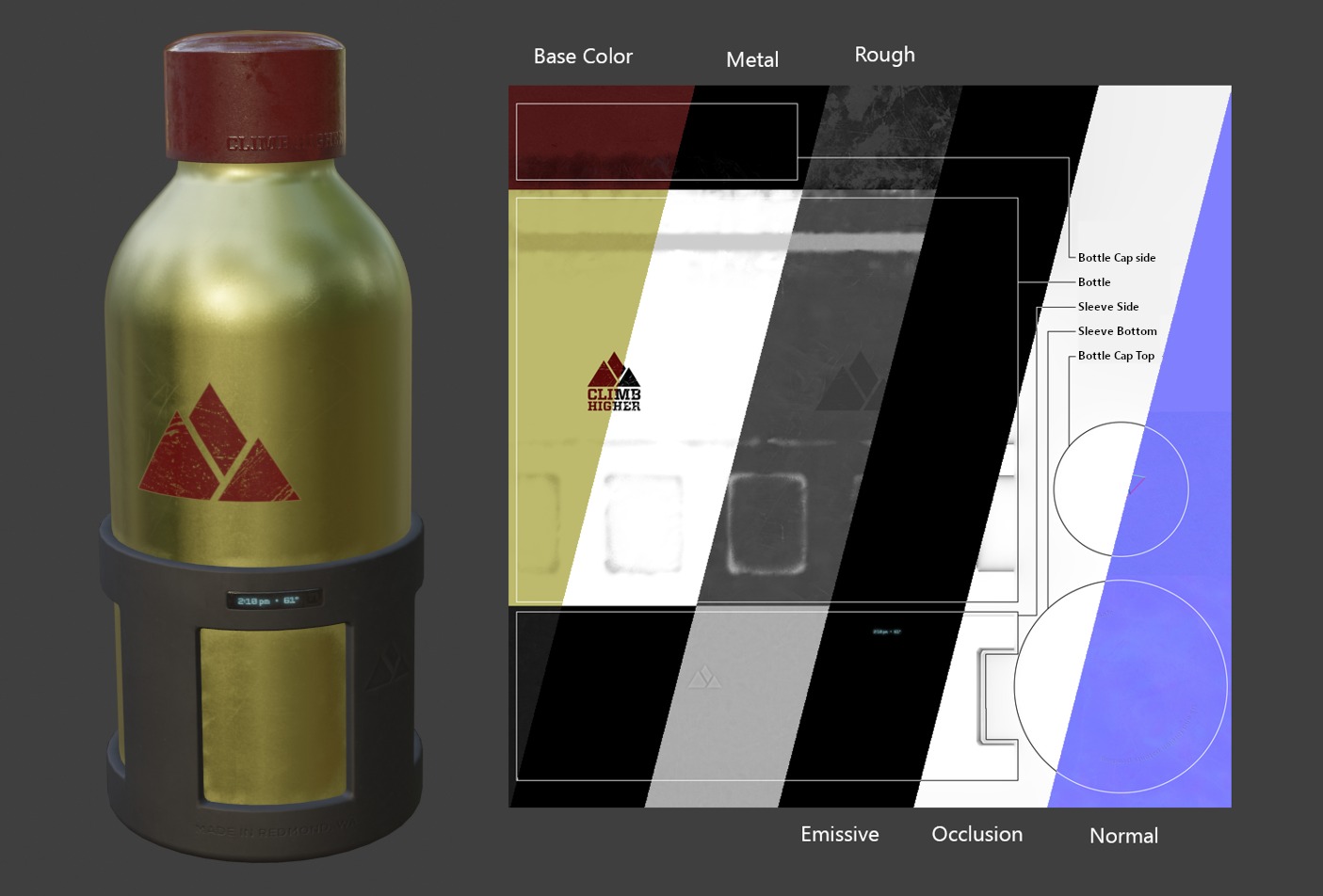
Un ejemplo de los varios mapas de imágenes disponibles en el formato central glTF 2.0. Este es el modelo de ejemplo de la botella para agua mostrado junto con las partes de sus varios mapas de imágenes.
Materiales importados
El sistema de materiales glTF es diferente de los propios materiales de Blender. Cuando un archivo glTF es importado, el add-on construirá un conjunto de nodos Blender para replicar cada material glTF tan parecido como sea posible.
The importer supports Metal/Rough PBR (core glTF), Spec/Gloss PBR (KHR_materials_pbrSpecularGlossiness)
and some extension materials. The complete list can be found in Extensions part of this documentation.
Truco
Examinar el resultado del proceso de importación de los materiales es una buena forma de ver ejemplos de los tipos de nodos de materiales y los ajustes que pueden ser exportados a glTF.
Materiales Exportados
El exportador soporta materiales Metal/Rough PBR (core glTF) y Shadeless (KHR_materials_unlit). Construirá un material glTF basándose en los nodos que reconozca en el material Blender. El proceso de exportación de materiales maneja los ajustes descritos debajo.
Nota
Cuando las texturas de imágenes son utilizadas por los materiales, glTF requiere que las imágenes estén en formato PNG o JPEG. El add-on convierte imágenes automáticamente a partir de otros formatos, incrementando el tiempo de exportación.
Color Base
El color base del glTF es determinado al buscar una entrada Base Color en un nodo Principled BSDF. Si la entrada no está conectada, el color por defecto de la entrada (el campo del color al lado del conector inconexo) es utilizado como Base Color para el material glTF.

Puede ser especificado un color base sólido directamente en el nodo.
Si el nodo Image Texture resulta estar conectado a la entrada Base Color, la imagen será utilizada como el color base del glTF.

Una imagen es utilizada como el color base del glTF.
Metallic and Roughness
Estos valores son leídos desde el nodo Principled BSDF. Si ambas entradas están desconectadas, el nodo mostrará sliders para controlar sus respectivos valores entre 0.0 y 1.0, y estos valores serán copiados en el glTF.
Cuando se usa una imagen, glTF espera que el valor metallic sea codificado en el canal azul (B), y el valor roughness sea codificado en el canal verde (G) de la misma imagen. Si las imágenes están conectadas al nodo Blender en una forma que no siga esta convención, el add-on puede intentar adaptar la imagen a la forma correcta durante la exportación (con un tiempo de exportación incrementado).
En el árbol de nodos de Blender, se recomienda usar un nodo Separar RVA para separar los canales de un nodo Image Texture, y conectar el canal verde (G) a Roughness, y el azul (B) a Metallic. El exportador glTF reconocerá esta disposición como la correspondiente al estándar de glTF, y eso le permitirá básicamente copiar la textura de la imagen en el archivo glTF durante la exportación.
El nodo Image Texture para esto debería tener su Color Space establecido a Non-Color.
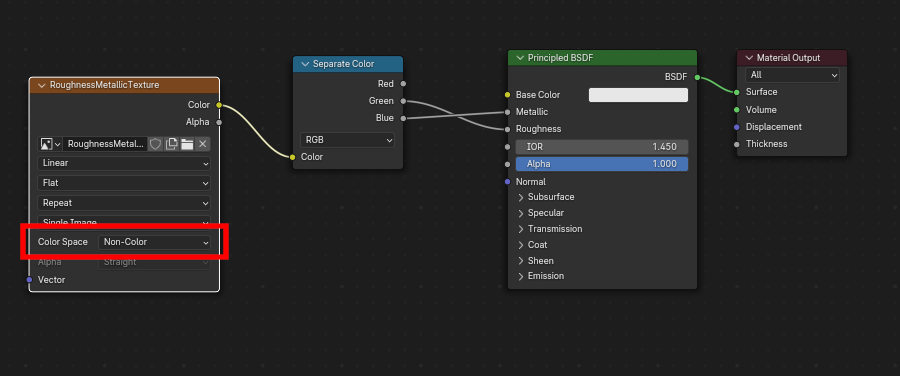
Una imagen metallic/roughness conectada de forma consistente con el estándar glTF, permitiéndole ser usada textualmente dentro de un archivo glTF exportado.
Baked Ambient Occlusion
glTF is capable of storing a baked ambient occlusion map.
Currently there is no arrangement of nodes that causes Blender
to use such a map in exactly the same way as intended in glTF.
However, if the exporter finds a custom node group by the name of glTF Material Output, and
finds an input named Occlusion on that node group,
it will look for an Image Texture attached there to use as the occlusion map in glTF.
The effect need not be shown in Blender, as Blender has other ways of showing ambient occlusion,
but this method will allow the exporter to write an occlusion image to the glTF.
This can be useful to real-time glTF viewers, particularly on platforms where there
may not be spare power for computing such things at render time.
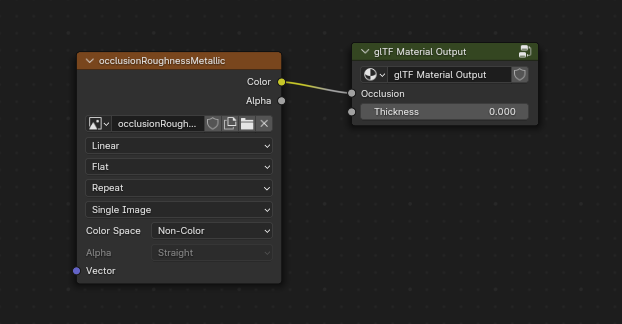
Un mapa de oclusión ambiental con pre-baking, conectado a un nodo que no renderiza, pero que exportará a glTF.
Truco
La forma más fácil de crear un grupo de nodos personalizado es importar un modelo glTF existente que contenga un mapa de oclusión, tal como la botella para agua u otro modelo existente. También puede ser usado un grupo de nodos personalizados creados manualmente.
glTF almacena la oclusión en el canal rojo (R), permitiéndole, de forma opcional, compartir la misma imagen con los canales roughness y metallic.

Esta combinación de nodos imita la forma en que glTF empaqueta los valores de oclusión, roughness y metallic, en una imagen simple.
Truco
The Cycles render engine has a Bake panel that can be used to bake
ambient occlusion maps. The resulting image can be saved and connected
directly to the glTF Material Output node.
Mapa de normales
Para usar un mapa de normales en glTF, hay que conectar la salida de color del nodo Image Texture con la entrada de color del nodo Normal Map y, entonces, conectar la salida normal de Normal Map con la entrada normal del nodo Principled BSDF. El nodo Image Texture para esto debería tener su propiedad Color Space establecida a Non-Color.
El nodo Normal Map debe permanecer con su propiedad por defecto de Tangent Space, puesto que este es el único tipo de mapa de normales actualmente soportado por glTF. La fortaleza del mapa de normales puede ser ajustada sobre este nodo. El exportador no está exportando directamente a dichos nodos, sino que los utilizará para ubicar la imagen correcta y copiará los ajustes de fortaleza en el glTF.
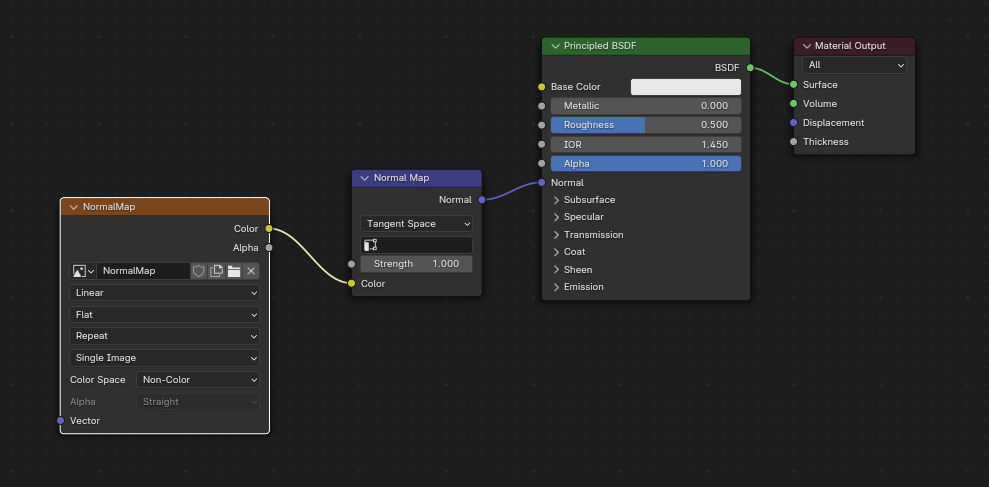
Una imagen de un mapa de normales conectado de tal forma que el exportador lo encontrará y lo copiará en el archivo glTF.
Truco
El motor de rendering, Cycles, tiene un panel Bake que puede ser utilizado para hacer el baking de los mapas de normales de espacio tangente a partir de prácticamente cualquier otra disposición de nodos de vectores de normales. Intercambiar el tipo Bake a Normal. Mantén los ajustes del espacio por defecto (espacio: Tangent, R: +X, G: +Y, B: +Z) cuando utilices este panel de baking para el glTF. La imagen resultante a la que se le hizo baking, puede ser guardada y conectada en un nuevo material utilizando el nodo Normal Map como se describió anteriormente, permitiéndole exportar de forma correcta.
Ver: Cycles Render Baking
Emisivo
Un nodo Image Texture puede ser conectado a la entrada Emission en el nodo Principled BSDF para incluir un mapa emisivo con el glTF. Alternativamente, el nodo Image Texture puede ser conectado a un nodo shader Emission y, opcionalmente, combinado con las propiedades de un nodo Principled BSDF, pasando por un nodo Add Shader.
Si el mapa emisivo es el único material, lo mejor es establecer Base Color por defecto a negro, y Roughness por defecto a 1.0. Esto minimiza la influencia de otros canales, si estos no son necesarios.

Esta disposición soporta la compatibilidad hacia atrás. Es más simple utilizar directamente al nodo Principled BSDF.
If any component of emissiveFactor is > 1.0, KHR_materials_emissive_strength extension will be used.
Barniz
When the Clearcoat input on the Principled BSDF node has a nonzero default value or
Image Texture node connected, the KHR_materials_clearcoat glTF extension will be
included in the export. This extension will also include a value or Image Texture
from the Clearcoat Roughness input if available.
If Image Textures are used, glTF requires that the clearcoat values be written to
the red (R) channel, and Clearcoat Roughness to the green (G) channel.
If monochrome images are connected, the exporter will remap them to these color channels.
The Clearcoat Normal input accepts the same kinds of inputs as the base Normal input, specifically a tangent-space normal map with +Y up, and a user-defined strength. This input can reuse the same normal map that the base material is using, or can be assigned its own normal map, or can be left disconnected for a smooth coating.
Todos los nodos Image Texture usados para sombreado de barniz deberían tener su Espacio de Color establecido a Non-Color.
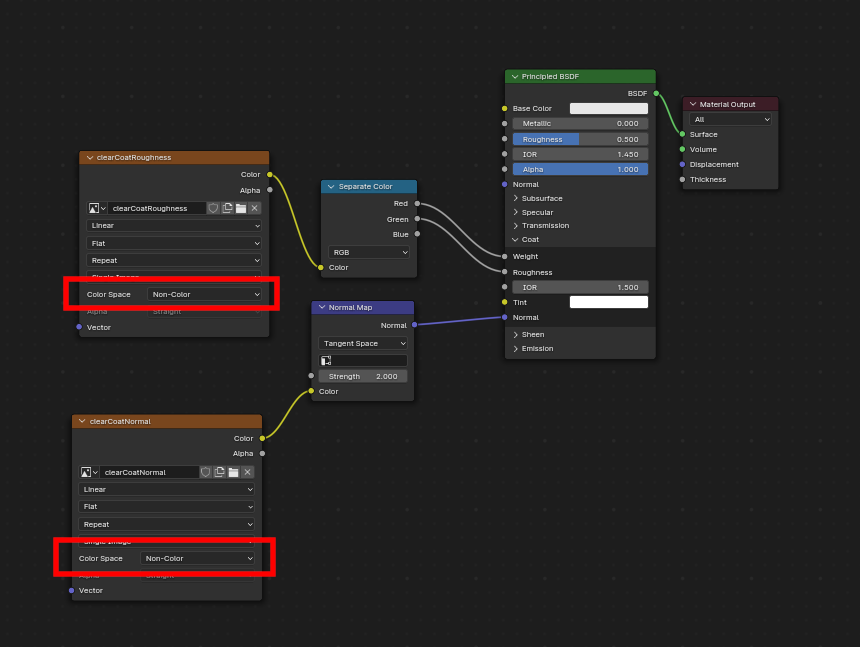
An example of a complex clearcoat application that will export correctly to glTF. A much simpler, smooth coating can be applied from just the Principled BSDF node alone.
Brillo
If a Sheen Roughness Texture is used, glTF requires the values be written to the alpha (A) channel.

Truco
El nodo BSDF Brillo sólo se encuentra disponible en el motor de procesamiento Cycles. Es posible que se deba cambiar temporalmente a Cycles para agregar este nodo y regresar luego a EEVEE.
Especularidad
When the Specular IOR Level or Specular Tint input of Principled BSDF node have a non default value or
Image Texture node connected, the KHR_materials_specular glTF extension will be
included in the export.
Transmisión
When the Transmission input on the Principled BSDF node has a nonzero default value or
Image Texture node connected, the KHR_materials_transmission glTF extension will be
included in the export. When a texture is used, glTF stores the values in the red (R) channel.
The Color Space should be set to Non-Color.
Transmission is different from alpha blending, because transmission allows full-strength specular reflections. In glTF, alpha blending is intended to represent physical materials that are partially missing from the specified geometry, such as medical gauze wrap. Transmission is intended to represent physical materials that are solid but allow non-specularly-reflected light to transmit through the material, like glass.
Truco
The material’s base roughness can be used to blur the transmission, like frosted glass.
Truco
Typically the alpha blend mode of a transmissive material should remain «Opaque», the default setting, unless the material only partially covers the specified geometry.
Nota
In real-time engines where transmission is supported, various technical limitations in the engine may determine which parts of the scene are visible through the transmissive surface. In particular, transmissive materials may not be visible behind other transmissive materials. These limitations affect physically-based transmission, but not alpha-blended non-transmissive materials.
Nota
If you want to enable refraction on your model, KHR_materials_transmission must also
be used in addition with KHR_materials_volume. See the dedicated Volume part of
the documentation.
Advertencia
Transmission is complex for real-time rendering engines to implement,
and support for the KHR_materials_transmission glTF extension is not yet widespread.
IR
At import, there are two different situation:
if
KHR_materials_ioris not set, IOR value of Principled BSDF node is set to 1.5, that is the glTF default value of IOR.If set, the
KHR_materials_ioris used to set the IOR value of Principled BSDF.
At export, IOR is included in the export only if one of these extensions are also used:
KHR_materials_transmissionKHR_materials_volumeKHR_materials_specular
IOR of 1.5 are not included in the export, because this is the default glTF IOR value.
Volumen
Volume can be exported using a Volume Absorption node, linked to Volume socket of Output node.
Data will be exported using the KHR_materials_volume extension.
For volume to be exported, some transmission must be set on Principled BSDF node.
Color of Volume Absorption node is used as glTF attenuation color. No texture is allowed for this property.
Density of Volume Absorption node is used as inverse of glTF attenuation distance.
Thickness can be plugged into the Thickness socket of custom group node
glTF Material Output.If a texture is used for thickness, it must be plugged on (
G) Green channel of the image.
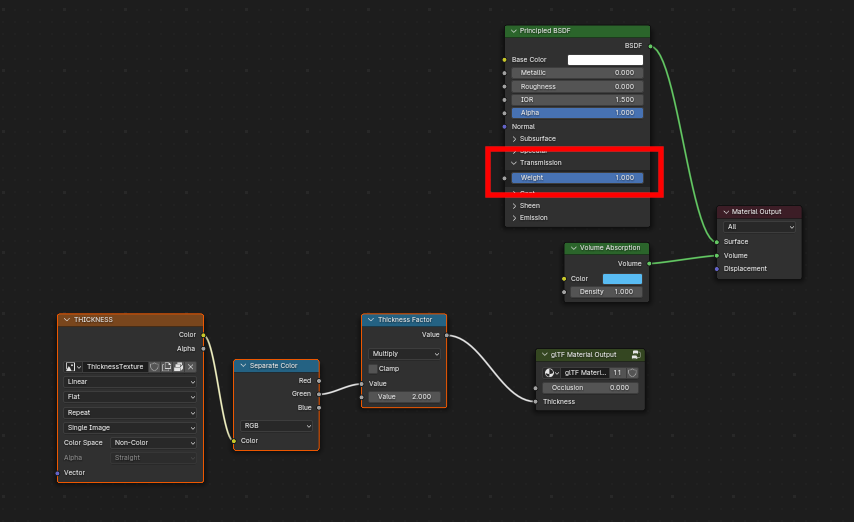
glTF Variants
Nota
For a full Variants experience, you have to enable UI in Add-on preferences
There are two location to manage glTF Variants in Blender
In 3D View, on
glTF VariantstabFor advanced settings, in Mesh Material Properties (see Advanced glTF Variant checks)
The main concept to understand for using Variants, is that each material slot will be used as equivalent of a glTF primitive.
glTF Variants switching
After importing a glTF file including KHR_materials_variants extension, all variants can be displayed.
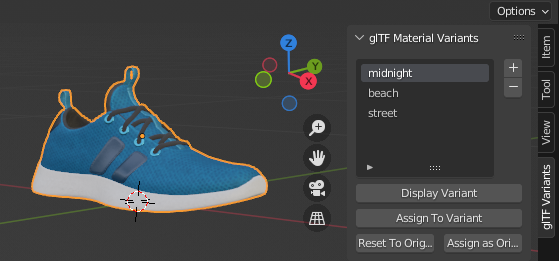
You can switch Variant, by selecting the variant you want to display, then clicking on Display Variant.
You can switch to default materials (when no Variant are used), by clicking on Reset to default.
glTF Variants creation
You can add a new Variant by clicking the + at right of the Variant list.
Then you can change the name by double-clicking.
After changing Materials in Material Slots, you can assign current materials to the active Variant using Assign to Variant.
You can also set default materials using Assign as Original.
These materials will be exported as default material in glTF.
This are materials that will be displayed by any viewer that don’t manage KHR_materials_variants extension.
Advanced glTF Variant checks
If you want to check primitive by primitive, what are Variants used, you can go to Mesh Material Properties.
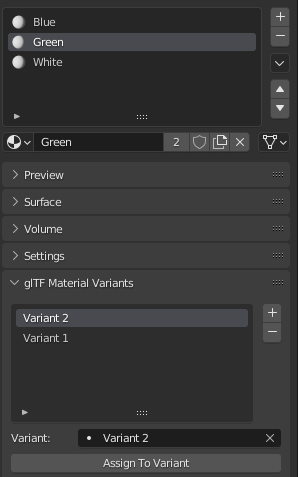
The glTF Material Variants tab refers to the active material Slot and Material used by this slot. You can see every Variants that are using this material for the given Slot/Primitive.
You can also assign material to Variants from this tab, but recommendation is to perform it from 3D View tab.
Double-Sided / Backface Culling
For materials where only the front faces will be visible, turn on Backface Culling in the Settings panel of an EEVEE material. When using other engines (Cycles, Workbench) you can temporarily switch to EEVEE to configure this setting, then switch back.
Deja esta caja sin seleccionar para los materiales de lados dobles.

La inversa de este ajuste lo controla la bandera DoubleSided de glTF.
Modos de Mezcla
La entrada Base Color, opcionalmente, puede proveer valores alfa. Cómo son tratados estos valores por glTF, depende del modo de mezcla seleccionado.
With the EEVEE render engine selected, each material has a Blend Mode on the material settings panel. Use this setting to define how alpha values from the Base Color channel are treated in glTF. Three settings are supported by glTF:
- Opaco
Los valores alfa son ignorados.
- Mezcla Alfa
Los valores alfa más bajos hacen que se mezcle con los objetos de fondo.
- Alpha Clip
Los valores alfa debajo del ajuste Clip Threshold harán que las porciones del material no sean dibujadas de ninguna forma. Todo lo demás se representa como opaco.
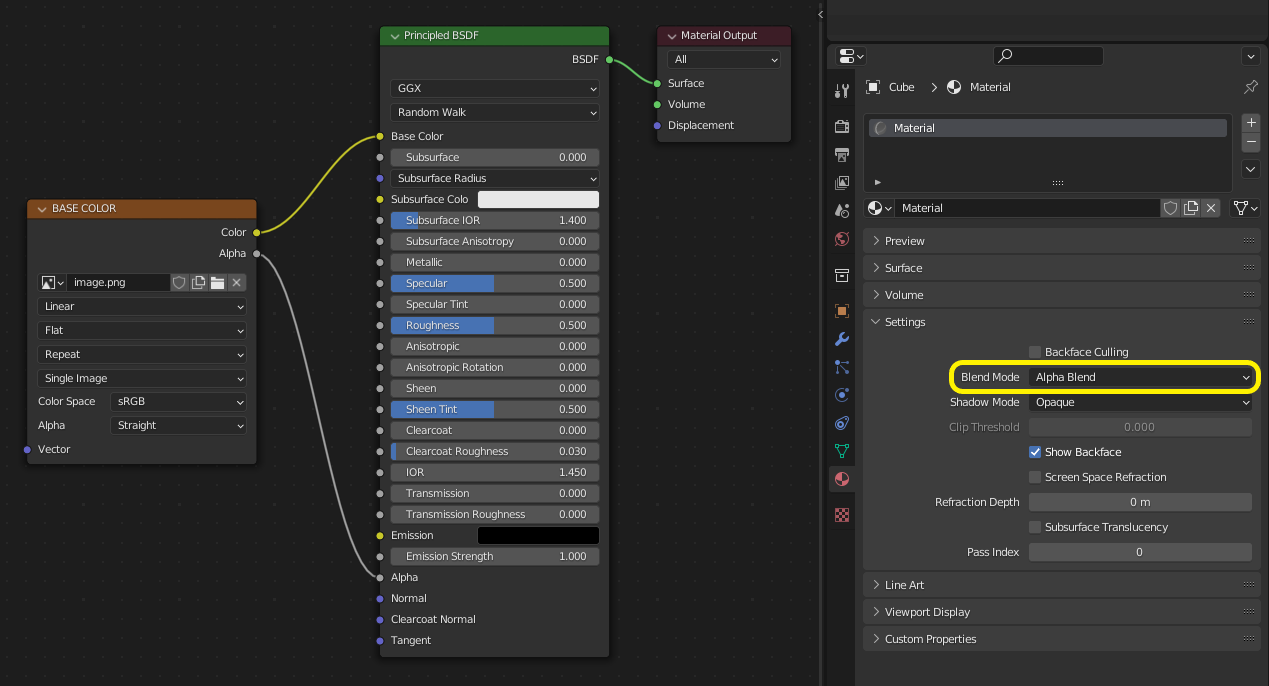
With the EEVEE engine selected, a material’s blend modes are configurable.
Nota
Sé consciente de que la transparencia (o modo Alpha Blend) es compleja para los motores que tengan que representarla en tiempo real, y puede comportarse de formas inesperadas después de la exportación. Cuando sea posible, utiliza en su lugar el modo Alpha Clip, o coloca polígonos Opaque detrás de sólo una capa simple de polígonos Alpha Blend.
UV Mapping
El control sobre la selección de mapas UV y las transformaciones está disponible al conectar un nodo Mapa UVy un nodo Mapping con un nodo Image Texture.
Los ajustes del nodo Mapping son exportados utilizando una extensión glTF llamada KHR_texture_transform. Hay un selector de tipos de mapeos sobre la parte de arriba. Point es el tipo recomendado para la exportación. Texture y Vector también son soportados. Los desplazamientos soportados son:
Location - X e Y
Rotation - sólo Z
Scale - X e Y
Para el tipo Texture, Scale X e Y deben ser iguales (escala uniforme).

Una elección intencional del mapeo UV.
Truco
Estos nodos son optativos. No todos los lectores de gITF soportan múltiples mapas UV o transformaciones de texturas.
Factores
Cualquier nodo Image Texture opcionalmente puede ser multiplicado por un color constante o un escalar. Estos serán escritos como factores en el archivo glTF, que son números que son multiplicados por las texturas de las imágenes especificadas. Éstos no son comunes.
Use Math node (multiply) for scalar factors. Use second value as factor
Use Mix node (color / multiply) for color factors. Set Factor to 1, and use Color2 (B) as factors
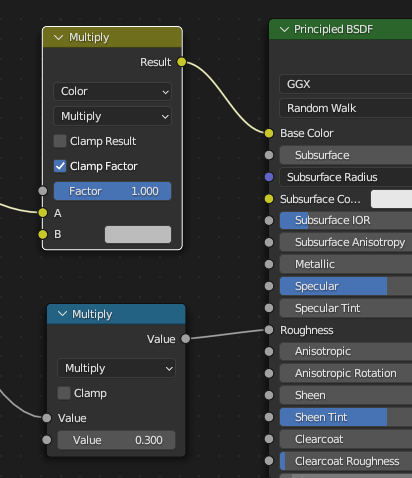
Ejemplo
Un material simple puede utilizar todo lo anterior al mismo tiempo, si se desea. Esta figura muestra una estructura de nodos típica cuando varias de las opciones anteriores son aplicadas a la vez:
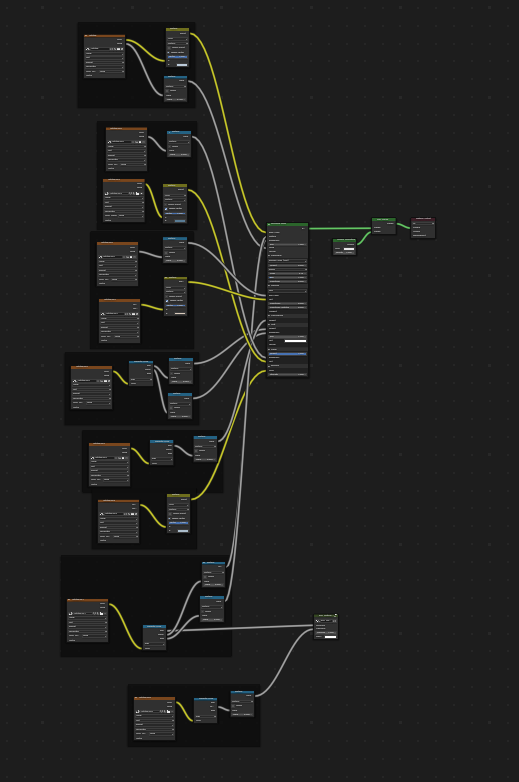
Un material Principled BSDF con una textura emisiva.
Exporting a Shadeless (Unlit) Material
To export an unlit material, mix in a camera ray, and avoid using the Principled BSDF node.
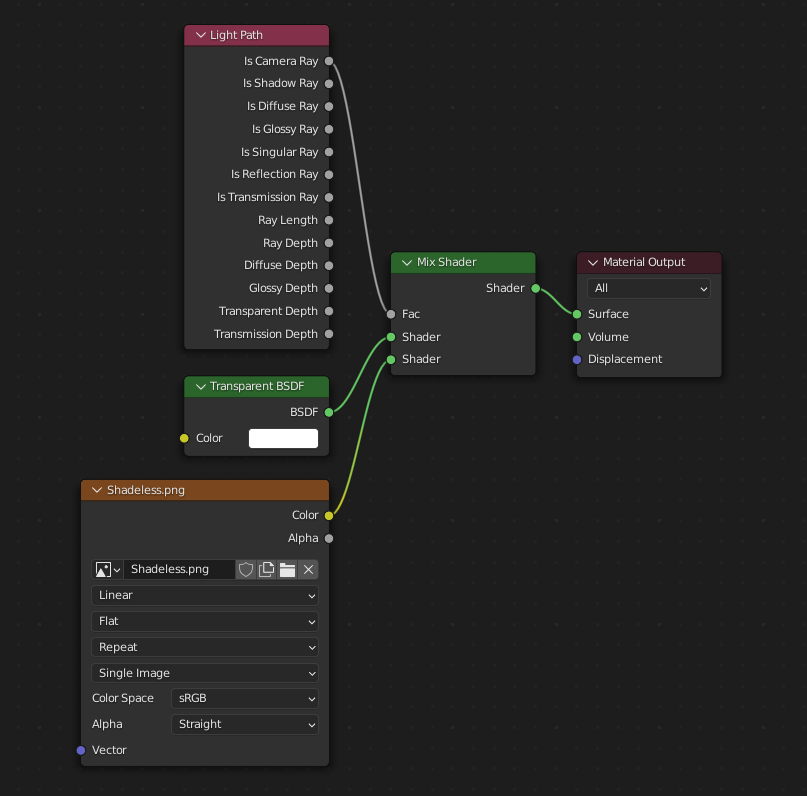
One of several similar node arrangements that will export
KHR_materials_unlit and render shadeless in Blender.
Extensiones
El formato central glTF 2.0 puede ser extendido con información extra, utilizando extensiones glTF. Esto permite que el formato del archivo mantenga detalles que no eran considerados universales en el momento de la primera publicación. No todos los lectores glTF soportan todas las extensiones, pero algunas son bastante comunes.
Certain Blender features can only be exported to glTF via these extensions. The following glTF 2.0 extensions are supported directly by this add-on:
Importar
KHR_materials_pbrSpecularGlossinessKHR_materials_clearcoatKHR_materials_transmissionKHR_materials_unlitKHR_materials_emissive_strengthKHR_materials_volumeKHR_materials_sheenKHR_materials_specularKHR_materials_iorKHR_variantes_materialesKHR_lights_punctualKHR_texture_transformKHR_mesh_quantizationEXT_mesh_gpu_instancing
Exportar
KHR_draco_mesh_compressionKHR_lights_punctualKHR_materials_clearcoatKHR_materials_transmissionKHR_materials_unlitKHR_materials_emissive_strengthKHR_materials_volumeKHR_materials_sheenKHR_materials_specularKHR_materials_iorKHR_variantes_materialesKHR_texture_transformEXT_mesh_gpu_instancing
Third-party glTF Extensions
Es posible que los desarrolladores de Python agreguen compatibilidad con Blender para extensiones glTF adicionales al escribir su propio complemento de terceros, sin modificar este complemento glTF. Para más información, ver el ejemplo en GitHub y si es necesario, registrar un prefijo de extensión.
Propiedades personalizadas
Custom properties are always imported, and will be exported from most objects
if the option is selected before export.
These are stored in the extras field on the corresponding object in the glTF file.
Unlike glTF extensions, custom properties (extras) have no defined namespace, and may be used for any user-specific or application-specific purposes.
Animaciones
A glTF animation changes the transforms of objects or pose bones, or the values of shape keys. One animation can affect multiple objects, and there can be multiple animations in a glTF file.
Importar
Imported models are set up so that the first animation in the file is playing automatically. Scrub the Timeline to see it play.
When the file contains multiple animations, the rest will be organized using the Nonlinear Animation editor. Each animation becomes an action stashed to an NLA track. The track name is the name of the glTF animation. To make the animation within that track visible, click Solo (star icon) next to the track you want to play.

This is the fox sample model showing its «Run» animation.
If an animation affects multiple objects, it will be broken up into multiple parts. The part of the animation that affects one object becomes an action stashed on that object. Use the track names to tell which actions are part of the same animation. To play the whole animation, you need to enable Solo (star icon) for all its tracks.
Nota
There is currently no way to see the non-animated pose of a model that had animations.
You can also use the animation switcher that can be found in DopeSheet editor.
Nota
You have to enable UI in Add-on preferences for seeing the animation switcher
You can switch all animation imported. It automatically enables Solo (star icon) for all needed tracks. It also reset non animated object to Rest transformation.
Exportar
You can export animations using different ways. How glTF animations are made from actions / NLA is controlled by the export option.
Acciones (por defecto)
An action will be exported if it is the active action on an object, or it is stashed to an NLA track (e.g. with the Stash or Push Down buttons in the Action Editor). Actions which are not associated with an object in one of these ways are not exported. If you have multiple actions you want to export, make sure they are stashed!
A glTF animation can have a name, which is the action name by default. You can override it
by renaming its NLA track from NLATrack/[Action Stash] to the name you want to use.
For example, the Fig. fox model will export with three animations,
«Survey», «Walk», and «Run».
If you rename two tracks on two different objects to the same name, they will become part
of the same glTF animation and will play together.
The importer organizes actions so they will be exported correctly with this mode.
This mode is useful if you are exporting for game engine, with an animation library of a character. Each action must be on its own NLA track.
Acciones activas fusionadas
In this mode, the NLA organization is not used, and only one animation is exported using the active actions on all objects.
Pistas NLA
En este modo, cada pista de NLA será exportada como un animación de glTF independiente. Este modo es útil si se usa los modificadores de clips, o si se obtiene multiple acciones en una misma pista.
If you rename two tracks on two different objects to the same name, they will become part of the same glTF animation and will play together.
Escena
Using Scene option, animations will be exported as you can see them in viewport. You can choose to export a single glTF animation, or each object separately.
Nota
Remember only certain types of animation are supported:
Object transform (location, rotation, scale)
Pose bones
Shape key values
Animation of other properties, like physics, lights, or materials, will be ignored.
Nota
In order to sample shape key animations controlled by drivers using bone transformations, they must be on a mesh object that is a direct child of the bones” armature.
Nota
Only Actions (default) and Active Actions merged mode can handle not sampled animations.
Variantes de los formatos de los archivos
La especificación glTF identifica diferentes formas en que los datos pueden ser almacenados. El importador las maneja a todas. El exportador le pedirá al usuario que seleccione una de las siguientes formas:
glTF Binary (.glb)
Esto produce un archivo .glb simple, con todos los datos de las mallas, las texturas de las imágenes y la información relacionada, empaquetada en un archivo binario simple.
Truco
Usar un archivo simple facilita el compartir o copiar el modelo en otros sistemas o servicios.
glTF Separate (.gltf + .bin + texturas)
Esto produce una archivo basado en texto JSON .gltf que describe la estructura completa, conjuntamente con un archivo .bin que contiene los datos de las mallas y los vectores y, opcionalmente, un número de archivos .png o .jpg que contienen las texturas de las imágenes referenciadas por el archivo .gltf.
Truco
Tener una diversidad de archivos separados, hace mucho más fácil que un usuario vuelva y edite cualquier JSON o imagen después de que la exportación se haya completado.
Nota
Sé consciente de que compartir este formato requiere compartir todos estos archivos separados como un grupo.
Propiedades
Importar
- Pack Images
Empaqueta todas las imágenes en un archivo blend.
- Merge Vertices
The glTF format requires discontinuous normals, UVs, and other vertex attributes to be stored as separate vertices, as required for rendering on typical graphics hardware. This option attempts to combine co-located vertices where possible. Currently cannot combine verts with different normals.
- Sombreado
Cómo las normales son computadas durante la importación.
- Guess Original Bind Pose
Determina la pose para los huesos (y, consecuentemente, las mallas con el skinning) en Modo Edición Cuando está activado, intenta adivinar la pose que fue utilizada para computar las matrices de vinculación inversas.
- Bone Direction
Changes the heuristic the importer uses to decide where to place bone tips. Note that the Fortune setting may cause inaccuracies in models that use non-uniform scaling. Otherwise this is purely aesthetic. The default value will not change axis, and is best for re-exporting from Blender. This default option will change display mode (adding shape and changing relationship line) to have a better view, even if original bones axis are not the most accurate (estheticaly speaking)
- Lighting Mode
Optional backwards compatibility for non-standard render engines. Applies to lights. Standard: Physically-based glTF lighting units (cd, lx, nt). Unitless: Non-physical, unitless lighting. Useful when exposure controls are not available Raw (Deprecated): Blender lighting strengths with no conversion
- Import WebP textures
If a texture exists in WebP format, loads the WebP texture instead of the fallback png/jpg one.
Exportar
- Formato
Ver: File Format Variations.
- Conservar Original
For glTF Separate file format only. Keep original textures files if possible. Warning: if you use more than one texture, where PBR standard requires only one, only one texture will be used. This can lead to unexpected results
- Texturas
For glTF Separate file format only. Folder to place texture files in. Relative to the gltf-file.
- Copyright
Derechos legales y condiciones para el modelo.
- Remember Export Settings
Almacena ajustes de exportación en un archivo blend, para que sean recordados la próxima vez que el archivo sea abierto.
Incluir
- Objetos seleccionados
Sólo exporta objetos seleccionados.
- Visible Objects
Export visible objects only.
- Objetos Renderizables
Export renderable objects only.
- Colección activa
Export objects from active collection only.
- Include Nested Collections
Only when Active Collection is On. When On, export recursively objects on nested active collections.
- Escena Activa
Export active scene only.
- Propiedades personalizadas
Export custom properties as glTF extras.
- Cámaras
Export cameras.
- Luces Puntuales
Exporta luces direccionales, de punto y focales. Utiliza la extensión glTF
KHR_lights_punctual.
Transformación
- Y Up
Exporta usando la conversión de glTF, +Y up.
Data - Scene Graph
- GPU Instances
Export using
EXT_mesh_gpu_instancingextensions.
Datos - Malla
- Aplicar modificadores
Export objects using the evaluated mesh, meaning the resulting mesh after all Modifiers have been calculated.
- UV
Exporta las UV (coordenadas de texturizado) junto con las mallas.
- Normales
Exporta las normales de los vértices junto con las mallas.
- Tangentes
Exporta las tangentes de los vértices junto con las mallas.
- Colores de vértices
Exporta los atributos de color junto con las mallas.
- Atributos
Export Attributes with meshes, when the name starts with underscore.
- Bordes sueltos
Export loose edges as lines, using the material from the first material slot.
- Puntos sueltos
Export loose points as glTF points, using the material from the first material slot.
Data - Material
- Materiales
Export full materials, only placeholders (all primitives but without materials), or does not export materials. (In that last case, primitives are merged, losing material slot information).
- Imágenes
Output format for images. PNG is lossless and generally preferred, but JPEG might be preferable for web applications due to the smaller file size. If WebP is chosen, all textures will be saved as WebP, without any png/jpg fallback. If None is chosen, materials are exported without textures.
- Calidad de imagen
When exporting jpeg or WebP files, the quality of the exported file.
- Create WebP
Creates WebP textures for every textures, in addition to the existing texture. For already WebP textures, nothing happen.
- WebP fallback
For all WebP textures, create a png fallback texture.
Datos - Formas clave
Exporta formas clave (objetivos de transformación)
- Shape Key Normals
Exporta las normales de los vértices con las claves de forma (objetivos de transformación).
- Shape Key Tangents
Exporta las tangentes de los vértices con las claves de forma (objetivos de transformación).
Data - Shape Keys - Optimize
- Use Sparse Accessor if better
Sparse Accessor will be used if it save space (if the exported file is smaller)
- Omitting Sparse Accessor if data is empty
If data is empty, omit to export SParce Accessor. Not all viewer managed it correctly, so this option is Off by default
Datos - Esqueleto
- Use Rest Position Armature
Export Armatures using rest position as joint rest pose. When Off, the current frame pose is used as rest pose.
- Exporta sólo huesos que producen alguna deformación (y los huesos necesarios para la jerarquía).
Export Deformation bones only, not other bones. Animation for deformation bones are baked.
- Aplanar jerarquía de huesos
Useful in case of non-decomposable TRS matrix.
Data - Skinning
Export skinning data
- Bone influences
How many joint verex influences will be exported. Models may appear incorrectly in many viewers with value different to 4 or 8.
- Include All Bone Influences
Export all joint vertex influences. Models may appear incorrectly in many viewers.
Datos - Iluminación
- Lighting Mode
Optional backwards compatibility for non-standard render engines. Applies to lights. Standard: Physically-based glTF lighting units (cd, lx, nt). Unitless: Non-physical, unitless lighting. Useful when exposure controls are not available Raw (Deprecated): Blender lighting strengths with no conversion
Datos - Compresión
Comprime mallas usando Google Draco.
- Compression Level
Mayor compresión produce menor codificación y decodificación.
- Quantization Position
Los valores mayores producen mejores tasas de compresión.
- Normal
Los valores mayores producen mejores tasas de compresión.
- Coordenadas de Textura
Los valores mayores producen mejores tasas de compresión.
- Color
Los valores mayores producen mejores tasas de compresión.
- Generic
Los valores mayores producen mejores tasas de compresión.
Animación
- Modo de Animación
Animation mode used for export (See Animations )
- Shape Keys Animations
Export Shape Keys Animation. Need Shape Keys to be exported (See Data - Shape Keys)
- Bake All Objects Animations
Useful when some objects are constrained without being animated themselves.
Animation - Rest & Ranges
- Use Current Frame as Object Rest Transformations
Export the scene in the current animation frame. When off, frame 0 is used as rest transformation for objects.
- Limit to Playback Range
Recorta las animaciones al rango de reproducción seleccionado.
- Set all glTF Animation starting at 0
Set all glTF Animation starting at 0. Can be useful for looping animation
- Negative Frames
When some frames are in negative range, slide or crop the animation.
Animation - Armature
- Export all Armature Actions
Export all actions, bound to a single armature. Warning: Option does not support exports including multiple armatures.
- Reset pose bones between actions
Reset pose bones between each action exported. This is needed when some bones are not keyed on some animations.
Animation - Sampling
Apply sampling to all animations. Do not sample animation can lead to wrong animation export.
- Frecuencia de muestreo
Cuán a menudo se evalúan los valores animados (en frames).
Animation - Optimize
- Optimize Animation Size
Reduce exported file size by removing duplicate keyframes when all identical.
- Force keeping channel for armature / bones
if all keyframes are identical in a rig, force keeping the minimal animation.
- Force keeping channel for objects
if all keyframes are identical for object transformations, force keeping the minimal animation
Contribuir
El importador/exportador está desarrollado a través del repositorio glTF-Blender-IO, donde puedes presentar reportes de errores, emitir solicitudes de características, o contribuir con código.
La discusión y el desarrollo del formato glTF 2.0 mismo tiene lugar en el Khronos Group glTF GitHub repository, y allí los comentarios son bienvenidos.
